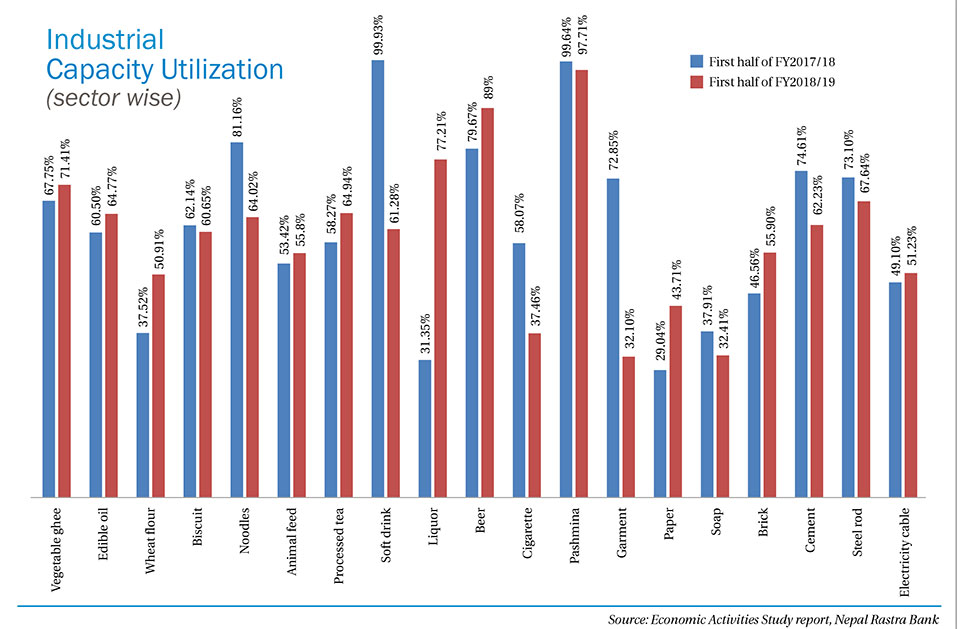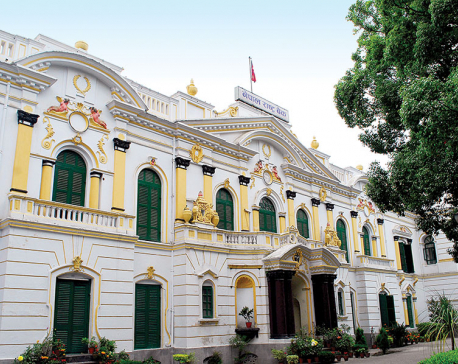
OR
Economic Activities Study report
Factories operating at 60% capacity, shows NRB report
Published On: July 11, 2019 08:07 AM NPT By: Sagar Ghimire | @sagarghi

NRB officials optimistic, but industrialists say more room for improvement
KATHMANDU, July 11: The average capacity utilization of Nepali factories has reached 60% over the first six months of the current fiscal year – FY2018/19, according to the latest study of economic activities of the country released by Nepal Rastra Bank (NRB) on Wednesday.
According to the half-yearly report entitled ‘Economic Activities Study’, the industrial capacity utilization – the rate that measures the extent or level of manufacturing and production of any industry or plant – inched up by two percentage points from the corresponding period of the last fiscal year – FY2017/18.
The central bank’s report is based on a survey conducted in major industries of 23 sectors in 57 districts. The survey found the rise in capacity utilization of soft drinks, jute products, processed leathers, paper and paper products, and plastic goods. On the other hand, capacity utilization of vegetable ghee and oil, processed milk, grains and poultry feeds, cigarette, resin, electricity wires and cables industries fell, according to the Economic Activities Survey.
An official of the NRB told Republica that the gradual rise in industrial capacity utilization indicates a progress in the performance of domestic industries that the government is promoting through various incentives and subsidies. “If you compare capacity utilization of last three or four years, you can see a gradual growth in performance of Nepal’s industrial and manufacturing sector. This is a positive signal that the industrial environment is improving and our domestic industries are become competitive,” Gunakar Bhatta, an executive director at the NRB, said.
While an uptick in capacity utilization rate indicates improving industrial outlook, private sector leaders say that there still is a lot of room for the progress.
“The capacity utilization rate has not gone down. That’s actually good. But, 60% of capacity utilization means 40% of our plants or machineries is sitting idle,” said Pashupati Murarka, an immediate past president of the Federation of Nepalese Chambers of Commerce and Industry (FNCCI). “Had easy and cheaper credit been available, the industrial output could have gone up. Higher industrial output means our industries will become competitive and their products will become cheaper,” added Murarka.
Some economists have concerns over slow growth in industrial capacity utilization despite having a government with two-thirds majority, relatively stable power supply and cordial labor relations.
But, NRB officials say that the survey results may not reflect the complete picture of the country’s industrial scenario. “First, the economic study was carried out in the first six months of the current fiscal year which means it does not reflect utilization rate of the second half of the fiscal year. Also, the sample that we have in this study does not capture the capacity utilization of many of the industries which entered the market in recent years,” said Bhatta, who heads the Research Department of the NRB.
“Also, the guidelines that govern the economic activities survey are quite old. We will revise it next year so that we can have a more real picture,” he added.
You May Like This

Brexit halves new investment in British car industry, auto industry lobby
LONDON, June 26: Uncertainty over Brexit has halved new investment in the British car industry as Prime Minister Theresa May’s... Read More...

Dev banks seek flexibility in prudential lending limit
KATHMANDU, June 19: Development Bankers Association Nepal (DBAN) has urged the Nepal Rastra Bank (NRB) to allow 'B' class development... Read More...

Hospitals too get permits to borrow in foreign currency
KATHMANDU, Sep 1: Nepal Rastra Bank (NRB) has paved the way for hospitals, which make earnings also in foreign currency, to... Read More...






Just In
- CM Kandel requests Finance Minister Pun to put Karnali province in priority in upcoming budget
- Australia reduces TR visa age limit and duration as it implements stricter regulations for foreign students
- Govt aims to surpass Rs 10 trillion GDP mark in next five years
- Govt appoints 77 Liaison Officers for mountain climbing management for spring season
- EC decides to permit public vehicles to operate freely on day of by-election
- Fugitive arrested after 26 years
- Indian Potash Ltd secures contract to bring 30,000 tons of urea within 107 days
- CAN adds four players to squad for T20 series against West Indies 'A'












Leave A Comment